2008奥运基础色彩(配图)
- 格式:pdf
- 大小:456.79 KB
- 文档页数:7
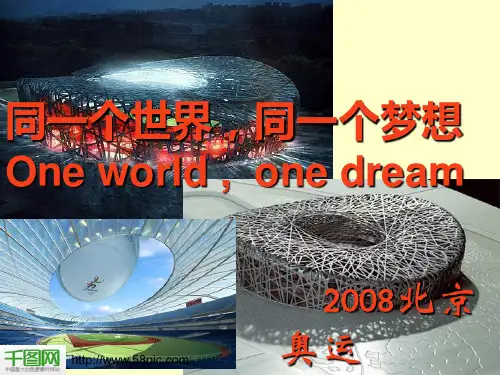
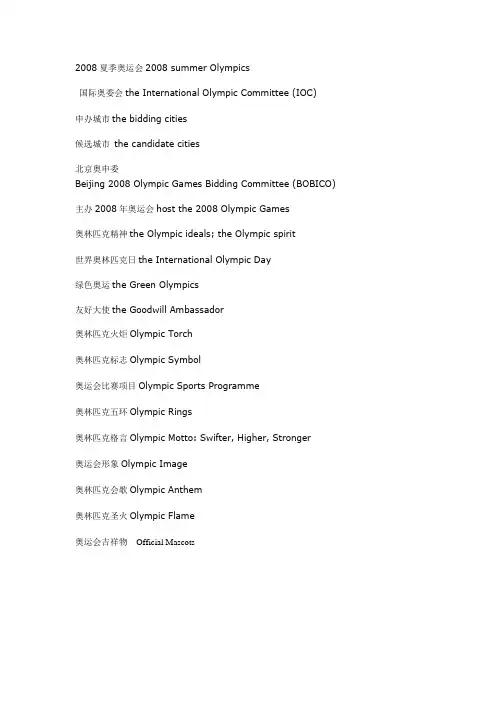
2008夏季奥运会2008 summer Olympics国际奥委会the International Olympic Committee (IOC)申办城市the bidding cities候选城市the candidate cities北京奥申委Beijing 2008 Olympic Games Bidding Committee (BOBICO) 主办2008年奥运会host the 2008 Olympic Games奥林匹克精神the Olympic ideals; the Olympic spirit世界奥林匹克日the International Olympic Day绿色奥运the Green Olympics友好大使the Goodwill Ambassador奥林匹克火炬Olympic Torch奥林匹克标志Olympic Symbol奥运会比赛项目Olympic Sports Programme奥林匹克五环Olympic Rings奥林匹克格言Olympic Motto: Swifter, Higher, Stronger奥运会形象Olympic Image奥林匹克会歌Olympic Anthem奥林匹克圣火Olympic Flame奥运会吉祥物Official Mascots2008北京奥运会吉祥物福娃英文介绍Like the Five Olympic Rings from which they draw their color and inspiration, Fuwa will serve as the Official Mascots of Beijing 2008 Olympic Games, carrying a message of friendship and peace--and blessings from China--to children all over the world. Designed to express the playful qualities of five little children who form an intimate circle of friends, Fuwa also embody the natural characteristics of four of China's most popular animals--the Fish, the Panda, the Tibetan Antelope, the Swallow--and the Olympic Flame. Each of Fuwa has a rhyming two-syllable name--a traditional way of expressing affection for children in China. Beibei is the Fish, Jingjing is the Panda, Huanhuan is the Olympic Flame, Yingying is the Tibetan Antelope and Nini is the Swallow. When you put their names together--Bei Jing Huan Ying Ni--they say "Welcome to Beijing," offering a warm invitation that reflects the mission of Fuwa as young ambassadors for the Olympic Games. Fuwa also embody both the landscape and the dreams and aspirations of people from every part of the vast country of China. In their origins and their headpieces, you can see the five elements of nature--the sea, forest, fire, earth and sky--all stylistic rendered in ways that represent the deep traditional influences of Chinese folk art and ornamentation. Spreading Traditional Chinese Blessings Wherever They Go In the ancient culture of China, there is a grand tradition of spreading blessings through signs and symbols. Each of Fuwa symbolizes a different blessing--and will honor this tradition by carrying their blessings to the children of the world. Prosperity, happiness, passion, health and good luck will be spread to every continent as Fuwa carry their invitation to Beijing 2008 to every part of the globe. At the heart of their mission--and through all of their work--Fuwa will seek to unite the world in peace and friendship through the Olympic spirit. Dedicated to helping Beijing 2008 spread its theme of One World, One Dream to every continent, Fuwa reflect the deep desire of the Chinese people to reach out to the world in friendship through the Games--and to invite every man, woman and child to take part in the great celebration of human solidarity that China will host in the light of the flame in 2008.In China's traditional culture and art, the fish and water designs are symbols of prosperity and harvest. And so Beibei carries the blessing of prosperity. A fish is also a symbol of surplus in Chinese culture, another measure of a good year and a good life. The ornamental lines of the water-wave designs are taken from well-known Chinese paintings of the past. Among Fuwa, Beibei is known to be gentle and pure. Strong in water sports, she reflects the blue Olympic ring.Jingjing makes children smile--and that's why he brings the blessing of happiness wherever he goes. You can see his joy in the charming naivety of his dancing pose and the lovely wave of his black and white fur. As a national treasure and a protected species, pandas are adored by people everywhere. The lotus designs in Jingjing's headdress, which are inspired by the porcelain paintings of the Song Dynasty (A.D.960-1234), symbolize the lush forest and the harmonious relationship between man and nature. Jingjing was chosen to represent our desire to protect nature's gifts--and to preserve the beauty of nature for all generations. Jingjing is charmingly naïve and optimistic. He is an athlete noted for strength who represents the black Olympic ring.In the intimate circle of Fuwa, Huanhuan is the big brother. He is a child of fire, symbolizing the Olympic Flame and the passion of sport--and passion is the blessing he bestows. Huanhuan stands in the center of Fuwa as the core embodiment of the Olympic spirit. And while he inspires all with the passion to run faster, jump higher and be stronger, he is also open and inviting. Wherever the light of Huanhuan shines, the inviting warmth of Beijing 2008--and the wishful blessings of the Chinese people--can be felt. The firery designs of his head ornament are drawn from the famed Dunhuang murals--with just a touch of China's traditional lucky designs. Huanhuan is outgoing and enthusiastic. He excels at all the ball games and represents the red Olympic ring.Like all antelopes, Yingying is fast and agile and can swiftly cover great stretches of land as he races across the earth. A symbol of the vastness of China's landscape, the antelope carries the blessing of health, the strength of body that comes from harmony with nature. Yingying's flying pose captures the essence of a species unique to the Qinghai-Tibet Plateau, one of the first animals put under protection in China. The selection of the Tibetan Antelope reflects Beijing commitment to a Green Olympics. His head ornament incorporates several decorative styles from the Qinghai-Tibet and Sinkiang cultures and the ethnic design traditions of Western China. Strong in track and field events, Yingying is a quick-witted and agile boy who represents the yellow Olympic ring.Every spring and summer, the children of Beijing have flown beautiful kites on the currents of wind that blow through the capital. Among the kite designs, the golden-winged swallow is traditionally one of the most popular. Nini's figure is drawn from this grand tradition of flying designs. Her golden wings symbolize the infinite sky and spread good-luck as a blessing wherever she flies. Swallow is also pronounced "yan" in Chinese, and Yanjing is what Beijing was called as an ancient capital city. Among Fuwa, Nini is as innocent and joyful as a swallow. She is strong in gymnastics and represents the green Olympic ring.据北京奥组委官方网站报道:福娃是北京2008年第29届奥运会吉祥物,其色彩与灵感来源于奥林匹克五环、来源于中国辽阔的山川大地、江河湖海和人们喜爱的动物形象。
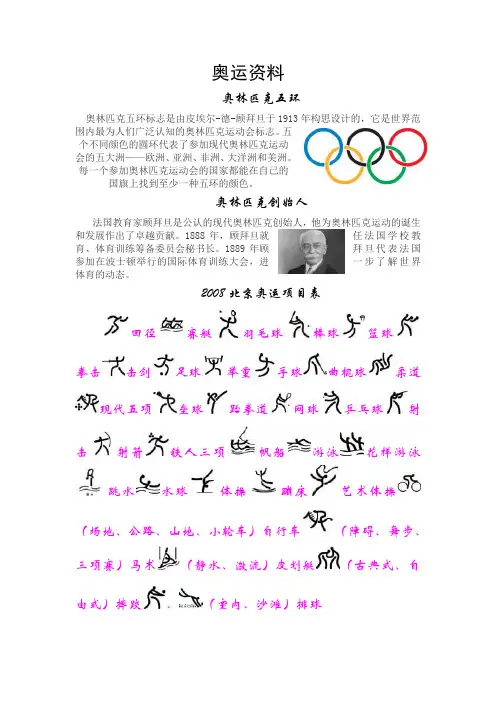
奥运资料奥林匹克五环奥林匹克五环标志是由皮埃尔-德-顾拜旦于1913年构思设计的,它是世界范围内最为人们广泛认知的奥林匹克运动会标志。
五个不同颜色的圆环代表了参加现代奥林匹克运动会的五大洲——欧洲、亚洲、非洲、大洋洲和美洲。
每一个参加奥林匹克运动会的国家都能在自己的国旗上找到至少一种五环的颜色。
奥林匹克创始人法国教育家顾拜旦是公认的现代奥林匹克创始人,他为奥林匹克运动的诞生和发展作出了卓越贡献。
1888年,顾拜旦就任法国学校教育、体育训练筹备委员会秘书长。
1889年顾拜旦代表法国参加在波士顿举行的国际体育训练大会,进一步了解世界体育的动态。
2008北京奥运项目表田径赛艇羽毛球棒球篮球拳击击剑足球举重手球曲棍球柔道现代五项垒球跆拳道网球乒乓球射击射箭铁人三项帆船游泳花样游泳跳水水球体操蹦床艺术体操(场地、公路、山地、小轮车)自行车(障碍、舞步、三项赛)马术(静水、激流)皮划艇(古典式、自由式)摔跤、(室内、沙滩)排球国家运动会会场——“鸟巢”场馆名称:国家体育场(鸟巢)建设地点:奥林匹克公园建筑面积(万㎡):25.8、座席数:永久座席80000个,临时性座席11000个赛时功能:田径、足球赛后功能:国际国内体育比赛和文化、娱乐活动开工时间:2003.12.24北京2008年奥运会开幕式和闭幕式的体育场馆第29届奥林匹克运动会的主会场,位于北京奥林匹克公园内、北京城市中轴线北端的东侧。
建筑面积25.8万平米,用地面积20.4万平米。
2008年奥运会期间,承担开幕式、闭幕式、田径比赛、男子足球决赛等赛事活动,能容纳观众10万人,其中临时坐席2万座。
奥运会后,可容纳观众8万人,可承担特殊重大体育比赛、各类常规赛事以及非竞赛项目,并将成为北京市提供市民广泛参与体育活动及享受体育娱乐的大型专业场所,成为全国具有标志性的体育娱乐建筑。
国家体育场的设计方案,是经全球设计招标产生的、由瑞士赫尔佐格和德梅隆设计事务所、奥雅纳工程顾问公司及中国建筑设计研究院设计联合体共同设计的“鸟巢”方案。
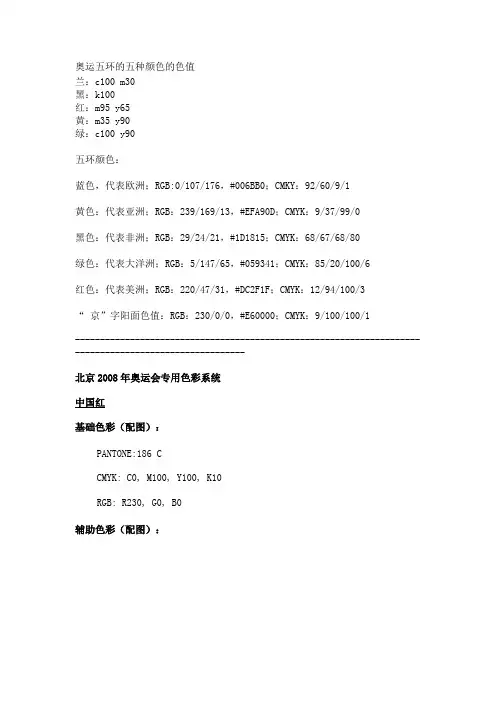
奥运五环的五种颜色的色值兰:c100 m30黑:k100红:m95 y65黄:m35 y90绿:c100 y90五环颜色:蓝色,代表欧洲;RGB:0/107/176,#006BB0;CMKY:92/60/9/1黄色:代表亚洲;RGB:239/169/13,#EFA90D;CMYK:9/37/99/0黑色:代表非洲;RGB:29/24/21,#1D1815;CMYK:68/67/68/80绿色:代表大洋洲;RGB:5/147/65,#059341;CMYK:85/20/100/6红色:代表美洲;RGB:220/47/31,#DC2F1F;CMYK:12/94/100/3“ 京”字阳面色值:RGB:230/0/0,#E60000;CMYK:9/100/100/1-------------------------------------------------------------------------------------------------------北京2008年奥运会专用色彩系统中国红基础色彩(配图):PANTONE:186 CCMYK: C0, M100, Y100, K10RGB: R230, G0, B0辅助色彩(配图):CMYK: C0, M100, Y65, K45PANTONE: 1788 CCMYK: C0, M85, Y90, K0RGB: R254, G40, B14PANTONE: 159 CCMYK: C0, M65, Y100, K5RGB: R242, G85, B0红色是北京的颜色,也是中国的象征。
红色的宫墙,红色的灯笼,红色的婚礼,红色的春联,从古至今,北京的生活中充满红色的装饰主题。
红色,构成了人们认同北京的颜色。
红色是激情和运动的颜色;红色是喜庆与祥和的颜色;红色是民俗与文化的颜色;红色也是北京奥运会会徽颜色的主色。
琉璃黄基础色彩(配图):Array PANTONE: 123 CCMYK: C0, M30, Y95, K0RGB: R255, G179, B15辅助色彩(配图):CMYK: C0, M50, Y100, K0PANTONE: 1245 CCMYK: C0, M25, Y90, K15RGB: R217, G162, B19PANTONE:129 CCMYK: C0, M15, Y75, K0RGB: R255, G217, B60黄色的琉璃瓦,金秋的树叶和丰收的农田,是北京最亮丽的色彩。
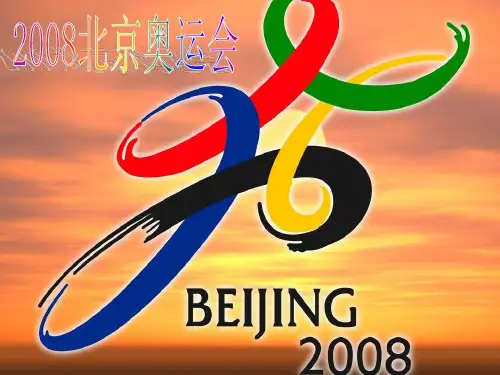
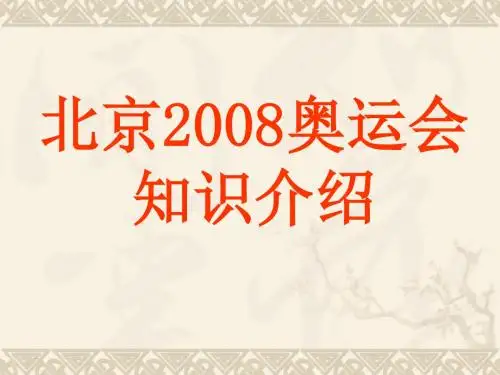
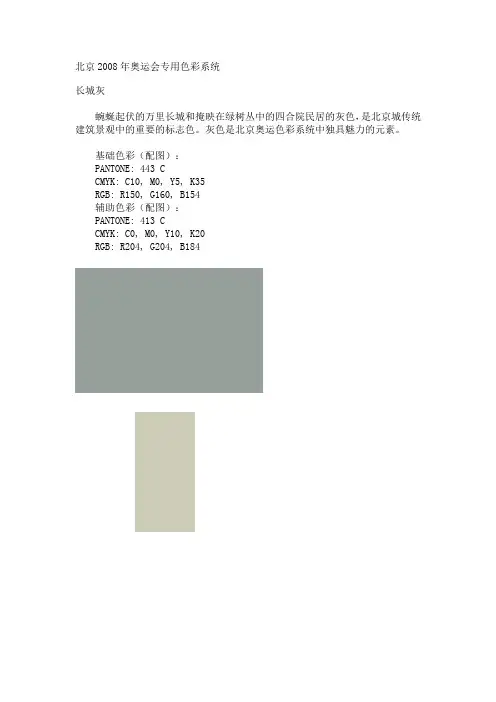
北京2008年奥运会专用色彩系统长城灰蜿蜒起伏的万里长城和掩映在绿树丛中的四合院民居的灰色,是北京城传统建筑景观中的重要的标志色。
灰色是北京奥运色彩系统中独具魅力的元素。
基础色彩(配图):PANTONE: 443 CCMYK: C10, M0, Y5, K35RGB: R150, G160, B154辅助色彩(配图):PANTONE: 413 CCMYK: C0, M0, Y10, K20RGB: R204, G204, B184国槐绿国槐是北京市市树,郁郁葱葱的国槐绿是自然的风采,是生命与环境的象征。
国槐绿寄寓着北京珍视自己的家园,与自然和谐发展,表达了“绿色奥运”理念。
基础色彩(配图):PANTONE:356 CCMYK: C100, M0, Y90, K25RGB: R0, G104, B52辅助色彩(配图):PANTONE: 363 CCMYK: C75, M0, Y100, K20RGB: R51, G132, B33PANTONE: 390 CCMYK: C30, M0, Y100, K5RGB: R170, G208, B16琉璃黄青花蓝温润而典雅的“青花蓝”,具有一种历史的美感,是北京丰富多彩的艺术宝藏中极具代表性的色彩。
象征着文明与创造。
基础色彩(配图):PANTONE: 286 CCMYK: C100, M60, Y0, K5RGB: R11, G61, B146辅助色彩(配图):PANTONE: 299 CCMYK: C85, M20, Y0, K0RGB: R42, G139, B190玉脂白“君子佩玉”——自古以来中华民族以佩玉为道德与修养的标志,“羊脂玉”更是玉中极品。
玉又是中国传统文化中吉祥如意的象征。
白色是北京奥运会会徽色彩构成重要元素之一,将在奥运会色彩系统中起着重要的协调作用。
基础色彩(配图):CMYK: C0, M0, Y0, K0RGB: R255, G255, B255中国红红色是北京的颜色,也是中国的象征。
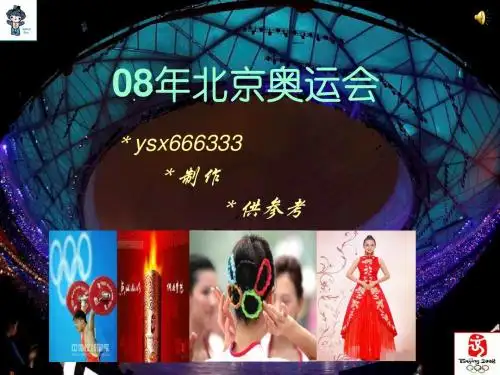
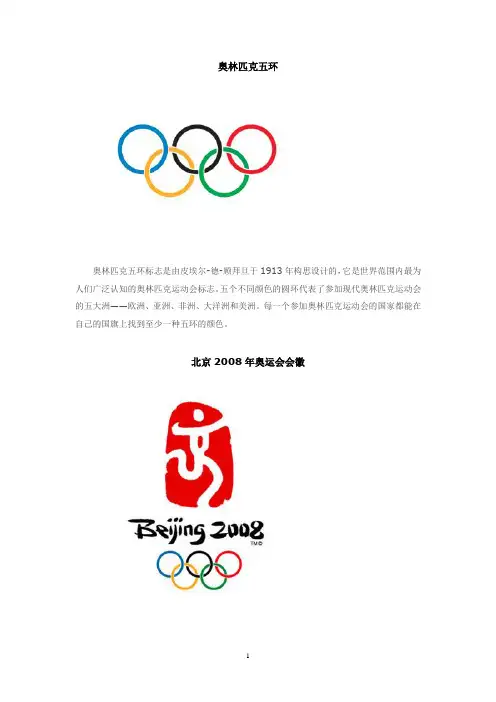
奥林匹克五环奥林匹克五环标志是由皮埃尔-德-顾拜旦于1913年构思设计的,它是世界范围内最为人们广泛认知的奥林匹克运动会标志。
五个不同颜色的圆环代表了参加现代奥林匹克运动会的五大洲——欧洲、亚洲、非洲、大洋洲和美洲。
每一个参加奥林匹克运动会的国家都能在自己的国旗上找到至少一种五环的颜色。
北京2008年奥运会会徽北京2008奥运会会徽说明每一个会徽的后面都讲述着一个故事。
在这个故事里充溢着中国北京的盛情和期盼。
在这个会徽中记载着中国北京向世界做出的承诺。
这就是“舞动的北京”,这就是“北京奥运会会徽”。
里程碑“舞动的北京”是一座奥林匹克的里程碑。
它是用中华民族精神镌刻、古老文明意蕴书写、华夏子孙品格铸就出的一首奥林匹克史诗中的经典华章;它简洁而深刻,展示着一个城市的演变与发展;它凝重而浪漫,体现着一个民族的思想与情怀。
在通往“北京2008”的路程上,人们将通过它相约北京、相聚中国、相识这里的人们。
承诺“舞动的北京”是一方中国之印。
这方“中国印”镌刻着一个有着十三亿人口和五十六个民族的国家对于奥林匹克运动的誓言;见证着一个拥有古老文明和现代风范的民族对于奥林匹克精神的崇尚;呈现着一个面向未来的都市对奥林匹克理想的诉求。
它是诚信的象征;它是自信的展示;它是第29届奥林匹克运动会主办城市北京向全世界、全人类做出的庄严而又神圣的承诺。
“精诚所至,金石为开”,这枚以先贤明言创意、以金石印章为形象的会徽,是中国人民对于奥林匹克的敬重与真诚。
当我们郑重地印下这方“中国印”之时,就意味着2008年的中国北京将为全世界展现一幅“和平、友谊、进步”的壮美图画,将为全人类奏响“更快、更高、更强”的激情乐章。
形象“舞动的北京”是这个城市的面容。
它是一种形象,展现着中华汉字所呈现出的东方思想和民族气韵;它是一种表情,传递着华夏文明所独具的人文特质和优雅品格。
借中国书法之灵感,将北京的“京”字演化为舞动的人体,在挥毫间体现“新奥运” 的理念。
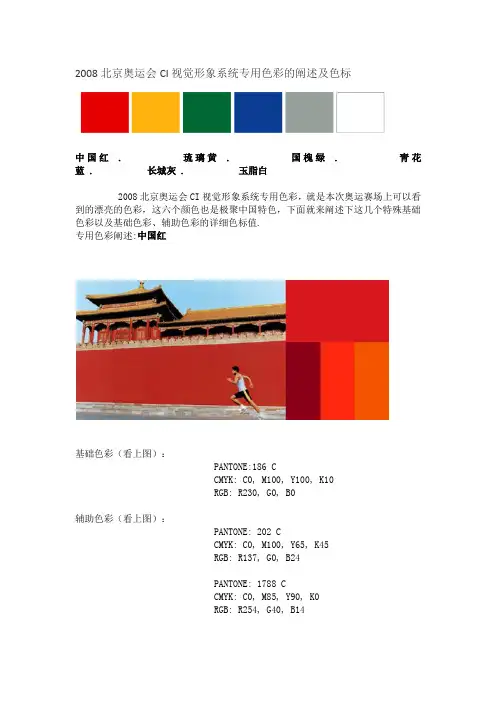
2008北京奥运会CI视觉形象系统专用色彩的阐述及色标中国红 . 琉璃黄 . 国槐绿 . 青花蓝 . 长城灰 . 玉脂白2008北京奥运会CI视觉形象系统专用色彩,就是本次奥运赛场上可以看到的漂亮的色彩,这六个颜色也是极聚中国特色,下面就来阐述下这几个特殊基础色彩以及基础色彩、辅助色彩的详细色标值.专用色彩阐述:中国红基础色彩(看上图):PANTONE:186 CCMYK: C0, M100, Y100, K10RGB: R230, G0, B0辅助色彩(看上图):PANTONE: 202 CCMYK: C0, M100, Y65, K45RGB: R137, G0, B24PANTONE: 1788 CCMYK: C0, M85, Y90, K0RGB: R254, G40, B14PANTONE: 159 CCMYK: C0, M65, Y100, K5RGB: R242, G85, B0红色是北京的颜色,也是中国的象征。
红色的宫墙,红色的灯笼,红色的婚礼,红色的春联,从古至今,北京的生活中充满红色的装饰主题。
红色,构成了人们认同北京的颜色。
红色是激情和运动的颜色;红色是喜庆与祥和的颜色;红色是民俗与文化的颜色;红色也是北京奥运会会徽颜色的主色。
专用色彩阐述:琉璃黄基础色彩(看上图):PANTONE: 123 CCMYK: C0, M30, Y95, K0RGB: R255, G179, B15辅助色彩(看上图):PANTONE: 152 CCMYK: C0, M50, Y100, K0RGB: R255, G127, B0PANTONE: 1245 CCMYK: C0, M25, Y90, K15RGB: R217, G162, B19PANTONE:129 CCMYK: C0, M15, Y75, K0RGB: R255, G217, B60黄色的琉璃瓦,金秋的树叶和丰收的农田,是北京最亮丽的色彩。
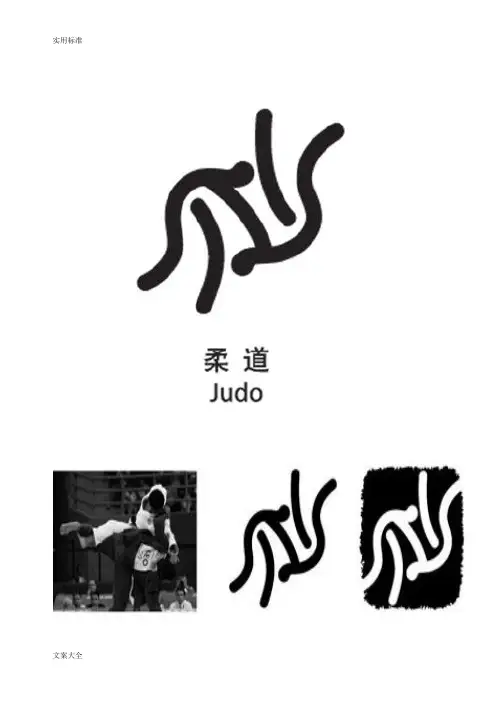
贝贝贝贝的灵感来源:中国年画——莲年有余、中国传统鱼纹样、水浪纹样。
贝贝传递的祝福是繁荣。
她是一条小鲤鱼。
在中国传统文化艺术中,“鱼”和“水”的图案是繁荣与收获的象征,人们用“鲤鱼跳龙门”寓意事业有成和梦想的实现,“鱼”还有吉庆有余、年年有余的蕴涵。
贝贝的头部纹饰使用了中国新石器时代的鱼纹图案。
她温柔纯洁,是水上运动的高手,和奥林匹克五环中的蓝环相互辉映。
晶晶晶晶的灵感来源:我国濒危珍稀动物:熊猫、宋代瓷器莲花造型。
晶晶是一只憨态可掬的大熊猫,无论走到哪里都会带给人们欢乐。
作为中国国宝,大熊猫深得世界人民的喜爱。
晶晶来自广袤的森林,象征着人与自然的和谐共存。
他的头部纹饰源自宋瓷上的莲花瓣造型。
晶晶憨厚乐观,充满力量,他代表奥林匹克五环中黑色的一环。
欢欢欢欢的灵感来源:中国传统火纹图案、敦煌壁画中的火焰纹样。
欢欢是福娃中的大哥哥。
他是一个火娃娃,象征奥林匹克圣火。
欢欢是运动激情的化身,他将激情散播世界,传递更快、更高、更强的奥林匹克精神。
欢欢所到之处,洋溢着2008对世界的热情。
它代表奥林匹克五环中红色的一环。
迎迎迎迎的灵感来源:我国特有的珍稀动物:藏羚羊。
迎迎是一只机敏灵活、驰骋如飞的藏羚羊,他来自中国辽阔的西部大地,将健康美好的祝福传向世界。
迎迎是青藏高原特有的保护动物藏羚羊,是绿色奥运的展现。
迎迎的头部纹饰融入了青藏高原和新疆等西部地区的装饰风格。
他身手敏捷,是田径好手,他也代表奥林匹克五环中黄色的一环妮妮妮妮的灵感来源:的传统:沙燕风筝,雨燕妮妮来自天空,是一只展翅飞翔的燕子,其造型创意来自传统的沙燕风筝。
“燕”还代表燕京(古代的称谓)。
她把春天和喜悦带给人们,飞过之处播撒“祝您好运”的美好祝福。
天真无邪、欢快矫捷的妮妮将在体操比赛中闪亮登场,她代表奥林匹克五环中绿色的一环。
中国红基础色彩(配图):
PANTONE:186 C
CMYK: C0, M100, Y100, K10
RGB: R230, G0, B0
辅助色彩(配图):
PANTONE: 202 C
CMYK: C0, M100, Y65, K45
RGB: R137, G0, B24
PANTONE: 1788 C
CMYK: C0, M85, Y90, K0
RGB: R254, G40, B14
PANTONE: 159 C
CMYK: C0, M65, Y100, K5
RGB: R242, G85, B0
红色是北京的颜色,也是中国的象征。
红色的宫墙,红色的灯笼,红色的婚礼,红色的春联,从古至今,北京的生活中充满红色的装饰主题。
红色,构成了人们认同北京的颜色。
红色是激情和运动的颜色;红色是喜庆与祥和的颜色;红色是民俗与文化的颜色;红色也是北京奥运会会徽颜色的主色。
琉璃黄
琉璃黄
基础色彩(配图):
PANTONE: 123 C
CMYK: C0, M30, Y95, K0
RGB: R255, G179, B15
辅助色彩(配图):
PANTONE: 152 C
CMYK: C0, M50, Y100, K0
PANTONE: 1245 C
CMYK: C0, M25, Y90, K15
RGB: R217, G162, B19
PANTONE:129 C
CMYK: C0, M15, Y75, K0
RGB: R255, G217, B60
黄色的琉璃瓦,金秋的树叶和丰收的农田,是北京最亮丽的色彩。
“琉璃黄”是北京城市风光特有的颜色,代表着北京独特的自然景观及人文与历史的精彩和辉煌。
黄色在中国的色彩文化中具有崇高的象征意义。
将在奥运会专用色彩系统中扮演明亮与欢快的角色。
国槐绿
国槐绿
基础色彩(配图):
PANTONE:356 C
CMYK: C100, M0, Y90, K25
RGB: R0, G104, B52
辅助色彩(配图):
PANTONE: 363 C
CMYK: C75, M0, Y100, K20
RGB: R51, G132, B33
PANTONE: 390 C
CMYK: C30, M0, Y100, K5
RGB: R170, G208, B16
国槐是北京市市树,郁郁葱葱的国槐绿是自然的风采,是生命与环境的象征。
国槐绿寄寓着北京珍视自己的家园,与自然和谐发展,表达了“绿色奥运”理念。
青花兰
青花兰
基础色彩(配图):
PANTONE: 286 C
CMYK: C100, M60, Y0, K5
RGB: R11, G61, B146
辅助色彩(配图):
PANTONE: 299 C
CMYK: C85, M20, Y0, K0
RGB: R42, G139, B190
温润而典雅的“青花蓝”,具有一种历史的美感,是北京丰富多彩的艺术宝藏中极具代表性的色彩。
象征着文明与创造。
长城灰
长城灰
基础色彩(配图):
PANTONE: 443 C
CMYK: C10, M0, Y5, K35
RGB: R150, G160, B154
辅助色彩(配图):
PANTONE: 413 C
CMYK: C0, M0, Y10, K20
RGB: R204, G204, B184
蜿蜒起伏的万里长城和掩映在绿树丛中的四合院民居的灰色,是北京城传统建筑景观中的重要的标志色。
灰色是北京奥运色彩系统中独具魅力的元素。
玉脂白
玉脂白
基础色彩(配图):
CMYK: C0, M0, Y0, K0
RGB: R255, G255, B255
“君子佩玉”——自古以来中华民族以佩玉为道德与修养的标志,“羊脂玉”更是玉中极品。
玉又是中国传统文化中吉祥如意的象征。
白色是北京奥运会会徽色彩构成重要元素之一,将在奥运会色彩系统中起着重要的协调作用。